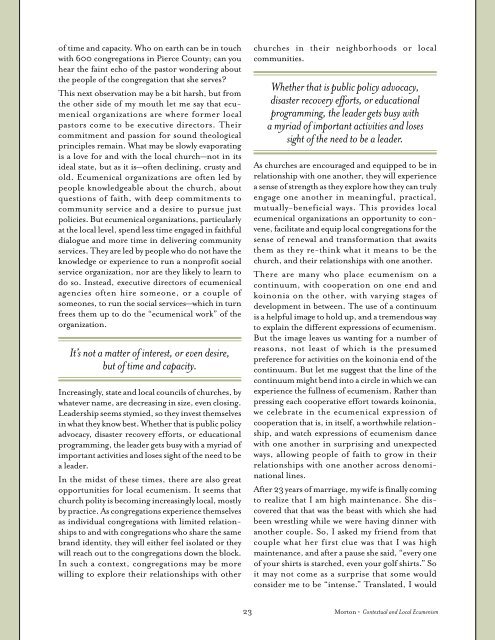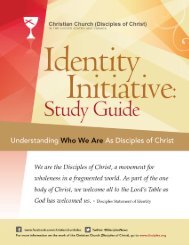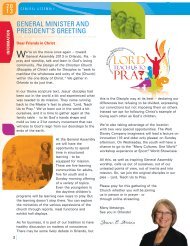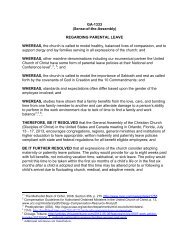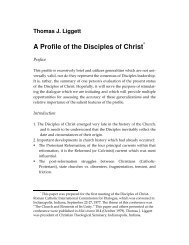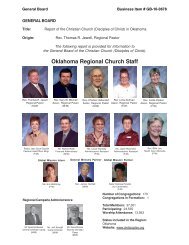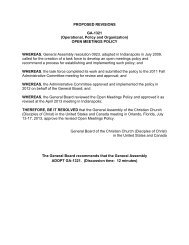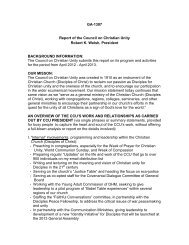RESOURCING THE CHURCH FOR ECUMENICAL MINISTRy A ...
RESOURCING THE CHURCH FOR ECUMENICAL MINISTRy A ...
RESOURCING THE CHURCH FOR ECUMENICAL MINISTRy A ...
You also want an ePaper? Increase the reach of your titles
YUMPU automatically turns print PDFs into web optimized ePapers that Google loves.
of time and capacity. Who on earth can be in touch<br />
with 600 congregations in Pierce County; can you<br />
hear the faint echo of the pastor wondering about<br />
the people of the congregation that she serves?<br />
This next observation may be a bit harsh, but from<br />
the other side of my mouth let me say that ecumenical<br />
organizations are where former local<br />
pastors come to be executive directors. Their<br />
commitment and passion for sound theological<br />
principles remain. What may be slowly evaporating<br />
is a love for and with the local church—not in its<br />
ideal state, but as it is—often declining, crusty and<br />
old. Ecumenical organizations are often led by<br />
people knowledgeable about the church, about<br />
questions of faith, with deep commitments to<br />
community service and a desire to pursue just<br />
policies. But ecumenical organizations, particularly<br />
at the local level, spend less time engaged in faithful<br />
dialogue and more time in delivering community<br />
services. They are led by people who do not have the<br />
knowledge or experience to run a nonprofit social<br />
service organization, nor are they likely to learn to<br />
do so. Instead, executive directors of ecumenical<br />
agencies often hire someone, or a couple of<br />
someones, to run the social services—which in turn<br />
frees them up to do the “ecumenical work” of the<br />
organization.<br />
It’s not a matter of interest, or even desire,<br />
but of time and capacity.<br />
Increasingly, state and local councils of churches, by<br />
whatever name, are decreasing in size, even closing.<br />
Leadership seems stymied, so they invest themselves<br />
in what they know best. Whether that is public policy<br />
advocacy, disaster recovery efforts, or educational<br />
programming, the leader gets busy with a myriad of<br />
important activities and loses sight of the need to be<br />
a leader.<br />
In the midst of these times, there are also great<br />
opportunities for local ecumenism. It seems that<br />
church polity is becoming increasingly local, mostly<br />
by practice. As congregations experience themselves<br />
as individual congregations with limited relationships<br />
to and with congregations who share the same<br />
brand identity, they will either feel isolated or they<br />
will reach out to the congregations down the block.<br />
In such a context, congregations may be more<br />
willing to explore their relationships with other<br />
23<br />
churches in their neighborhoods or local<br />
communities.<br />
Whether that is public policy advocacy,<br />
disaster recovery efforts, or educational<br />
programming, the leader gets busy with<br />
a myriad of important activities and loses<br />
sight of the need to be a leader.<br />
As churches are encouraged and equipped to be in<br />
relationship with one another, they will experience<br />
a sense of strength as they explore how they can truly<br />
engage one another in meaningful, practical,<br />
mutually-beneficial ways. This provides local<br />
ecumenical organizations an opportunity to convene,<br />
facilitate and equip local congregations for the<br />
sense of renewal and transformation that awaits<br />
them as they re-think what it means to be the<br />
church, and their relationships with one another.<br />
There are many who place ecumenism on a<br />
continuum, with cooperation on one end and<br />
koinonia on the other, with varying stages of<br />
development in between. The use of a continuum<br />
is a helpful image to hold up, and a tremendous way<br />
to explain the different expressions of ecumenism.<br />
But the image leaves us wanting for a number of<br />
reasons, not least of which is the presumed<br />
preference for activities on the koinonia end of the<br />
continuum. But let me suggest that the line of the<br />
continuum might bend into a circle in which we can<br />
experience the fullness of ecumenism. Rather than<br />
pressing each cooperative effort towards koinonia,<br />
we celebrate in the ecumenical expression of<br />
cooperation that is, in itself, a worthwhile relationship,<br />
and watch expressions of ecumenism dance<br />
with one another in surprising and unexpected<br />
ways, allowing people of faith to grow in their<br />
relationships with one another across denominational<br />
lines.<br />
After 23 years of marriage, my wife is finally coming<br />
to realize that I am high maintenance. She discovered<br />
that that was the beast with which she had<br />
been wrestling while we were having dinner with<br />
another couple. So, I asked my friend from that<br />
couple what her first clue was that I was high<br />
maintenance, and after a pause she said, “every one<br />
of your shirts is starched, even your golf shirts.” So<br />
it may not come as a surprise that some would<br />
consider me to be “intense.” Translated, I would<br />
Morton • Contextual and Local Ecumenism


